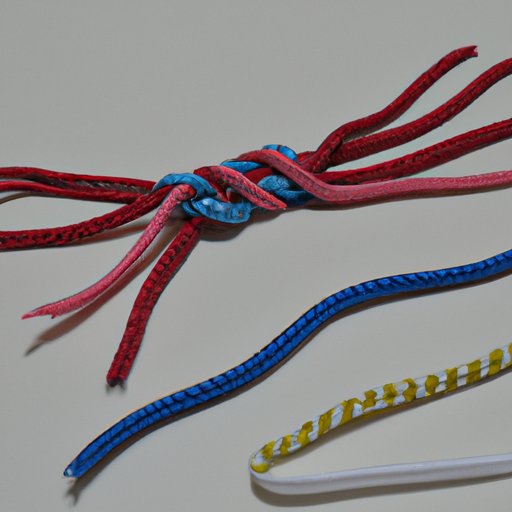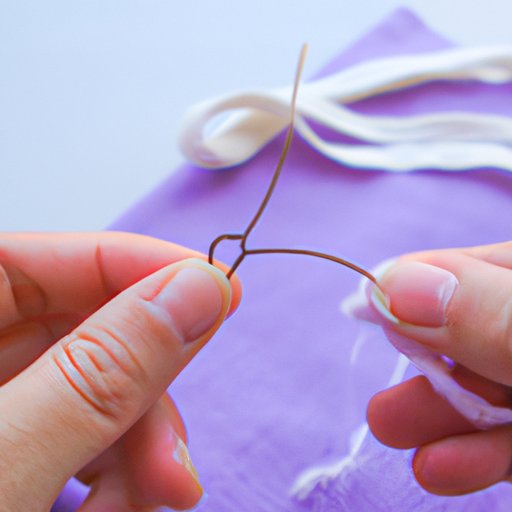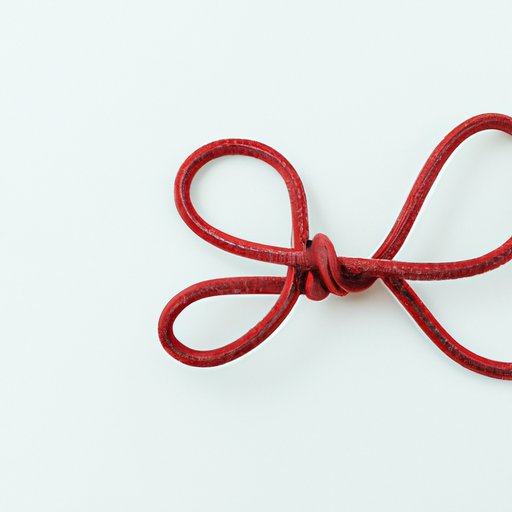Introduction
A sewing knot is a type of knot used in sewing and crafting. It is used to secure the thread when beginning or ending a stitch. Sewing knots are essential to ensure that the stitching remains intact and does not unravel. Knowing how to tie a secure and durable sewing knot is an essential skill for anyone who wants to create beautiful garments, quilts, and other handmade items. In this article, we will discuss the basics of sewing knots, provide a step-by-step guide for tying the perfect knot, and offer some tips and tricks for creating a secure and durable knot.
Step-by-Step Guide to Tying the Perfect Sewing Knot
Before you begin, make sure you have the proper supplies. You will need a needle, thread, and scissors. Once you have all of your supplies, follow these steps to create the perfect knot:
- Cut the thread to the desired length and thread the needle.
- Leave a tail of about 2 inches at the end of the thread.
- Wrap the tail around the needle twice.
- Hold the thread taut with one hand, and use the other hand to push the needle through the loops of thread.
- Pull the thread tight to create a knot.
- Trim the excess thread.
Tips and Tricks for Creating a Secure Sewing Knot
Creating a secure and durable sewing knot requires more than just following the right steps. Here are some tips and tricks to make sure your knot is secure and won’t come undone:
- Use Quality Thread: Quality thread is essential for creating a strong and secure knot. Make sure to choose a high-quality thread that won’t fray or break easily.
- Choose the Right Knot: Different types of knots are better suited for different tasks. Make sure you choose the right knot for the job.
- Make Sure Knots Are Tight: Pull the thread taut to ensure that the knot is as tight as possible. This will help to ensure that the knot doesn’t come undone.

An Overview of Different Sewing Knots and How to Craft Them
There are many different types of knots that can be used in sewing and crafting. Here is an overview of some of the most common ones and how to craft them:
- Slip Knot: The slip knot is one of the easiest and most commonly used knots. To create a slip knot, start by making a loop with the thread and then pull the end of the thread through the loop. Pull the thread tight to secure the knot.
- Overhand Knot: The overhand knot is another easy knot to master. Simply wrap the thread around itself once and then pull the end of the thread through the loop. Pull the thread tight to secure the knot.
- Surgeon’s Knot: The surgeon’s knot is slightly more complicated than the slip knot or the overhand knot. To create the surgeon’s knot, start by making a loop with the thread and then pull the end of the thread through the loop. Wrap the thread around the loop again and then pull the end of the thread through the loop again. Pull the thread tight to secure the knot.
- Square Knot: The square knot is a bit more complex than the other knots. To create the square knot, start by making a loop with the thread and then pull the end of the thread through the loop. Wrap the thread around the loop again and then pull the end of the thread through the loop. Cross the thread over itself and then pull the end of the thread through the loop again. Pull the thread tight to secure the knot.
A Beginner’s Guide to Making a Durable Sewing Knot
Making a durable sewing knot requires a few basic steps. Here is a quick beginner’s guide to creating a secure and durable knot:
- Pull the Thread Taut: Make sure to pull the thread taut before tying the knot. This will help to ensure that the knot is as tight as possible.
- Tighten the Knot: Once the knot is tied, make sure to pull the thread taut again to ensure that the knot is secure and won’t come undone.
- Double Knot for Extra Security: For extra security, you can double knot the thread. To do this, simply tie two knots in succession and then pull the thread taut to secure the knot.

Common Mistakes to Avoid When Making a Sewing Knot
To ensure that your knot is secure and won’t come undone, it’s important to avoid common mistakes. Here are some of the most common mistakes to avoid when making a sewing knot:
- Not Pulling the Thread Taut Enough: Make sure to pull the thread taut before and after tying the knot. This will help to ensure that the knot is as secure as possible.
- Not Tightening the Knot: Once the knot is tied, make sure to pull the thread taut again to ensure that the knot is secure and won’t come undone.
- Not Doubling the Knot: For extra security, you can double knot the thread. To do this, simply tie two knots in succession and then pull the thread taut to secure the knot.

Sewing Knots 101: All You Need to Know to Get Started
Learning how to tie a secure and durable sewing knot takes practice and patience. Before you get started, here are some tips to keep in mind:
- Selecting the Right Thread: Quality thread is essential for creating a strong and secure knot. Make sure to choose a high-quality thread that won’t fray or break easily.
- Choosing the Appropriate Knot: Different types of knots are better suited for different tasks. Make sure you choose the right knot for the job.
- Practicing and Patience: Learning how to tie a secure and durable knot takes practice and patience. Don’t be discouraged if it takes a few tries to get it right.
Conclusion
Creating a secure and durable sewing knot requires more than just following the right steps. Knowing the basics of sewing knots, understanding the different types of knots, and practicing are all essential skills for crafting the perfect knot. With some patience and practice, you can master the art of tying a secure and durable sewing knot. After reading this article, you should now have the knowledge and confidence to get started with creating your own sewing knots.
The benefits of learning how to tie sewing knots include being able to create beautiful garments, quilts, and other handmade items. With the right supplies, knowledge, and practice, you can create secure and durable sewing knots that will last for years to come.
(Note: Is this article not meeting your expectations? Do you have knowledge or insights to share? Unlock new opportunities and expand your reach by joining our authors team. Click Registration to join us and share your expertise with our readers.)
